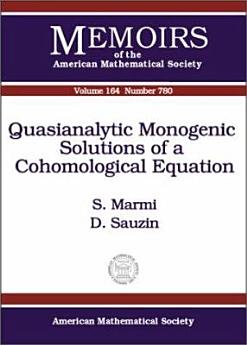Quasianalytic Monogenic Solutions of a Cohomological Equation
Stefano Marmi · D. Sauzin
Ene 2003 · Memoirs of the American Mathematical Society: American Mathematical Society Aklat 780 · American Mathematical Soc.
E-book
83
Mga Page
reportHindi na-verify ang mga rating at review Matuto Pa
Tungkol sa ebook na ito
We prove that the solutions of a cohomological equation of complex dimension one and in the analytic category have a monogenic dependence on the parameter, and we investigate the question of their quasi analyticity. This cohomological equation is the standard linearized conjugacy equation for germs of holomorphic maps in a neighborhood of a fixed point. The parameter is the eigenvalue of the linear part, denoted by $q$. Borel's theory of non-analytic monogenic functions has been first investigated by Arnold and Herman in the related context of the problem of linearization of analytic diffeomorphisms of the circle close to a rotation.Herman raised the question whether the solutions of the cohomological equation had a quasi analytic dependence on the parameter $q$. Indeed they are analytic for $q\in\mathbb{C}\setminus\mathbb{S}^1$, the unit circle $\S^1$ appears as a natural boundary (because of resonances, i.e. roots of unity), but the solutions are still defined at points of $\mathbb{S}^1$ which lie 'far enough from resonances'. We adapt to our case Herman's construction of an increasing sequence of compacts which avoid resonances and prove that the solutions of our equation belong to the associated space of monogenic functions; some general properties of these monogenic functions and particular properties of the solutions are then studied.For instance the solutions are defined and admit asymptotic expansions at the points of $\mathbb{S}^1$ which satisfy some arithmetical condition, and the classical Carleman Theorem allows us to answer negatively to the question of quasi analyticity at these points. But resonances (roots of unity) also lead to asymptotic expansions, for which quasi analyticity is obtained as a particular case of Ecalle's theory of resurgent functions.And at constant-type points, where no quasi analytic Carleman class contains the solutions, one can still recover the solutions from their asymptotic expansions and obtain a special kind of quasi analyticity. Our results are obtained by reducing the problem, by means of Hadamard's product, to the study of a fundamental solution (which turns out to be the so-called $q$-logarithm or 'quantum logarithm'). We deduce as a corollary of our work the proof of a conjecture of Gammel on the monogenic and quasi analytic properties of a certain number-theoretical Borel-Wolff-Denjoy series.
I-rate ang e-book na ito
Ipalaam sa amin ang iyong opinyon.
Impormasyon sa pagbabasa
Mga smartphone at tablet
I-install ang Google Play Books app para sa Android at iPad/iPhone. Awtomatiko itong nagsi-sync sa account mo at nagbibigay-daan sa iyong magbasa online o offline nasaan ka man.
Mga laptop at computer
Maaari kang makinig sa mga audiobook na binili sa Google Play gamit ang web browser ng iyong computer.
Mga eReader at iba pang mga device
Para magbasa tungkol sa mga e-ink device gaya ng mga Kobo eReader, kakailanganin mong mag-download ng file at ilipat ito sa iyong device. Sundin ang mga detalyadong tagubilin sa Help Center para mailipat ang mga file sa mga sinusuportahang eReader.








